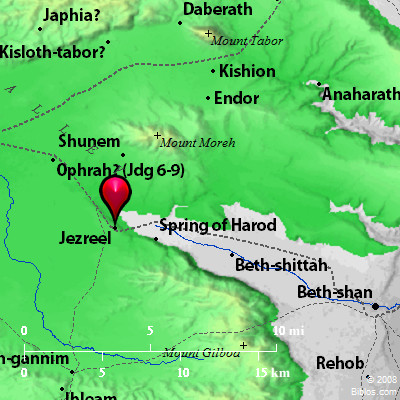Encyclopedia
JEZREELjez'-re-el, jez'-rel (yizre`e'l, "God soweth"):
(1) A city on the border of the territory of Issachar (Joshua 19:18).
1. Territory:
It is named with Chesulloth and Shunem (modern Iksal and Solam). It remained loyal to the house of Saul, and is mentioned as part of the kingdom over which Abner set Ishbosheth (2 Samuel 2:9). From Jezreel came the tidings of Saul and Jonathan's death on Gilboa, which brought disaster to Mephibosheth (2 Samuel 4:4). The city plays no important part in the history till the time of Ahab. Attracted, doubtless, by the fine position and natural charms of the place, he made it one of his royal residences, building here a palace (1 Kings 21:1). This was evidently on the eastern wall; and the gate by which Jehu entered was over-looked by the quarters of Queen Jezebel (2 Kings 9:30 f). The royal favor naturally enhanced the dignity of the city, and "elders" and "nobles" of Jezreel are mentioned (1 Kings 21:8, etc.). Under the influence of Jezebel, an institution for the worship of Baal was founded here, from which, probably, the men were drawn who figured in the memorable contest with Elijah on Carmel (2 Kings 10:11). "The tower in Jezreel" was part of the defenses of the city. It commanded a view of the approach up the valley from Beth-shean-the way followed by the hordes of the East, who, from time immemorial, came westward for the rich pasture of the plain (2 Kings 9:17). It was necessary also to keep constant watch, as the district East of the Jordan was always more unsettled than that on the West; and danger thence might appear at any moment. The garden of Naboth seems to have lain to the East of the city (2 Kings 9:21), near the royal domain, to which Ahab desired to add it as a garden of herbs (1 Kings 21:1). See NABOTH. This was the scene of the tragic meetings between Elijah and Ahab (1 Kings 21:17), and between Jehu and Joram and Ahaziah (2 Kings 9:21). Joram had returned to Jezreel from Ramoth-gilead to be healed of his wounds (2 Kings 9:15). By the gateway the dogs devoured Jezebel's body (2 Kings 9:31). Naboth had been stoned to death outside the city (1 Kings 21:13). Josephus lays the scene by the fountain of Jezreel, and here, he says, the dogs licked the blood washed from the chariot of Ahab (Ant., VIII, xv, 6). This accords with 1 Kings 21:19; but 22:38 points to the pool at Samaria.
2. Identification:
The site of Jezreel must be sought in a position where a tower would command a view of the road coming up the valley from Beth-shean. It has long been the custom to identify it with the modern village, Zer`in, on the northwestern spur of Gilboa. This meets the above condition; and it also agrees with the indications in Eusebius, Onomasticon as lying between Legio (Lejjun) and Scythopolis (Beisan). Recently, however, Professor A.R.S. Macalister made a series of excavations here, and failed to find any evidence of ancient Israelite occupation. This casts doubt upon the identification, and further excavation is necessary before any certain conclusion can be reached. For the "fountain which is in Jezreel," see HAROD, WELL OF.
(2) A town in the uplands of Judah (Joshua 15:56), the home of Ahinoam (1 Samuel 27:3, etc.).
W. Ewing
Strong's Hebrew
H1044: Beth-eqed"house of binding," a place in Palestine




